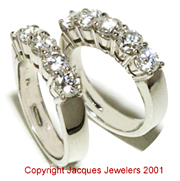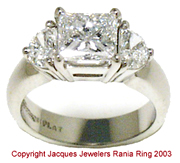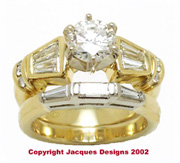Other
Enhancement Techniques
There are
various chemical coatings that can be used on a diamond to
temporarily enhance its color. Radiation treatments can be
applied to off-colored diamonds, turning low-value brownish
yellow stones into expensive fancy colored diamonds (pinks,
greens, blues, etc.). This is not fraud as long as it is disclosed.
However, this treatment is difficult to detect except by a
gem lab, and often, the diamonds are misrepresented as natural.
Fraudulent
Practices
Unless
you are a diamond expert, you can never be certain about the
identification or quality of a stone. One tip-off is a price
that's too good to be true. The actual value of a real diamond
is something that can be determined rather precisely. Most legitimate
sellers seek only a nominal profit on the sale and are not inclined
to sell a diamond for less than they could buy it for.
a.
Concealing Flaws in Mounting.
Although
there's nothing wrong with covering a flaw by proper placement
under a prong or bezel or some other setting, doing so for
the purpose of misrepresenting the quality of the stone
is not acceptable.
b.
Falsely Upgrading or Altering Certificates
When
a diamond is not accompanied by a grading report, some unscrupulous
sellers will represent the stone in an "overly optimistic"
fashion with regard to color and clarity grades. Some will
even change the information on the grading certificate to
make the diamond appear more valuable than it really is;
they've even used counterfeit certificates.
Artificial Diamonds
Most
people know that a diamond started life as a lump of carbon
(like a charcoal briquette) subjected to intense heat and pressure
under the earth - transforming it into the hardest (and most
desirable) material known to man. As you'd expect, there's been
a lot of interest in creating artificial diamonds in a laboratory
- a form of modern-day alchemy. Industrial-quality diamonds
have been available for decades and are used in grinding wheels,
drill bits, etc. Industrial diamonds are small, and appearance
is unimportant. However, after the breakup of the Soviet Union,
numerous crystal-growing labs sprang up in Russia and are now
producing created diamonds in good qualities and increasing
sizes. Most created diamonds are less than one carat in the
rough. Since 30% to 70% of the rough material is removed during
cutting, the majority of created diamonds end up as fractional
carat faceted stones. However, the growers have recently started
producing rough stones in 3-carat sizes, and we therefore expect
to see full-carat (and larger) cut diamonds on the market soon.
Nearly all created diamonds are an intense yellow-orange "fancy"
color, due to nitrogen introduced during processing. They're
very pretty, but the market for near colorless diamonds is much
larger than for the fancies. The crystal growers are working
on this problem, and we can expect to see "I" color grades and
better (all the way to "D" and "E" in the near future. Clarity
can be very good in synthetics, as high as GIA VS1. It is becoming
increasingly important to deal only with well-educated jewelers
who have trained Gemologists on staff to protect your interests
when purchasing a real diamond.
Diamond
Simulants
Whereas
a synthetic diamond is an actual diamond created in a laboratory,
a simulant is a "pretender," another "diamond-like" looking
stone that is substituted for the real thing.
Cubic
Zirconia
When
it first became commercially available many years ago, cubic
zirconia (or "CZ") fooled quite a few people. It doesn't
anymore, and many can tell it's not a real diamond at arm's
length. Nonetheless, there are some good fakes out there,
and you need to be careful if dealing with a seller you
don't know well.
Moissanite
Very
recently introduced the marketplace, moissanite is another
simulant. Its physical and optical properties are much closer
to a real diamond's. Not all gem lab equipment is capable
of detecting moissanite, although C3, the manufacturer,
is doing a brisk business selling their $500 detector to
pawn shops and jewelry merchants who buy diamonds "off the
street." Moissanite is strongly doubly refractive, so it
will pose no serious identification challenge to a knowledgeable
gemologist (who can detect the "facet doubling" by eye).
But, undoubtedly, it will fool many of the unwary for a
while. Opportunities for fraudulent misrepresentation will,
no doubt, abound with this new material. Fortunately, it
is still a fairly expensive imitation, so it will not be
as prevalent as "CZ" was when it first hit the scene.







